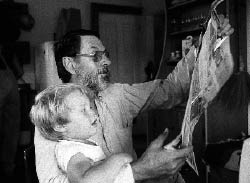Reasserting the Power of Robert Creeley's Verse
by Michael Kelleher

Since his death in March, 2005, poet Robert Creeley has been amply remembered and lauded on literary Web sites such as Conjunctions and tomraworth.com, as well as here in the pages of Artvoice, and in many memorials and celebrations around the world. Amid this chorus of praise, however, a persistently sour note has sounded in many an obituary. While mostly reverent, they bear within them a subtle undercurrent of doubt about Creeley’s literary legacy, implying that his far-reaching influence on American poetry rests more on the force of his persona than on the quality of his work.
In the coming days and weeks, the release of his two-volume collected poems by the University of California Press, along with several public forums on his work, including On Words: A Symposium on the Life and Work of Robert Creeley, which starts tonight in Buffalo, should go a long way toward putting such doubts to rest.
But where do these doubts come from? Why would a poet whose depth of feeling, technical virtuosity and oft-imitated style elicit such a critical backlash? Most of it has nothing to do with the work itself. As Amiri Baraka pointed out at the Robert Creeley birthday celebration in Buffalo in May, it has more than a little to do with America’s “rightward plunge,” which seeks to make all the “mass willfulness” of the postwar era into something “obscure, ugly or irrelevant.”
Creeley, Baraka, Charles Olson, Denise Levertov, Robert Duncan, Frank O’Hara, John Ashbery and Allen Ginsberg formed the nucleus of The New American Poetry 1945-60, the anthology that ushered in a sea change in American poetry during the 1960s. The New American Poetry marked a revolutionary moment in American letters, one in which poetry was taken out of the hands of the elect and put forcefully back into the public arena through a combination of savvy self-promotion, aesthetic experimentation and often a fearless foregrounding of political concerns. Creeley and his generation were not afraid to place their rage or their ideals on the page alongside their love and joy and despair.
For many in the poetry establishment (by which is meant a small cadre of powerful critics, and poets, for that matter, most of whom were comfortably ensconced in Iv(or)y Towers), The New American Poetry represented an attack on their authority and on the authority of the literary tradition on which that authority rests. Thus, they often responded defensively to the work of these poets, generalizing for instance that “Howl” was a pretty good effort, but that the rest of Ginsberg’s work is “uneven”—as if evenness were the highest accolade one could give to an artist’s work. More importantly, they regard the popularity of someone like Ginsberg and his status as a cultural icon as reasons to denigrate the work.
Creeley’s work often suffers a similar kind of downgrading. On the one hand, many mislabel him a “beat poet,” which gives these critics an excuse to dismiss the influence of his work as a byproduct of a zeitgeist rather than as a major aesthetic achievement. On the other, some critics suggest his poems are too spare to deserve critical attention. Many obituaries ran an insipid attack on the poems from critic John Simon (I know, who?): “They are short; they are not short enough.”
The truth of the matter is that this kind of response represents a massive failure of imagination on the part of the critical establishment, which in the last century seemed to believe a poem (or any literary work worth studying) was nothing more than a linguistic secret code in need of breaking, and the longer and denser the better. An industry of priestly code-breakers grew up around this spurious idea. In this atmosphere, Creeley’s lack of allusiveness was often treated more as lack of complexity than as a conscious aesthetic choice. Indeed, a revolutionary aesthetic choice.
Perhaps more importantly, Creeley’s work provides (for this reader at least) a crucial poetic experience that often eludes even the best critical assessments. That is, joy. Though often dark and harsh and unsparing in their regard of the world (and the poet himself), Creeley’s poems are a pleasure to read. One finds in them a virtually unrivaled sense of musical possibility in words—not the thumping iambs of traditional verse, but the elliptical syncopations of jazz combined with the nimble improvisational movement associated with action painting.
Read a Creeley poem out loud and you will get it. You don’t need a secret decoder ring or even a Harold Bloom to feel the pleasure it provides. It’s all there. In the words. To be sung.
|
Issue Navigation> Issue Index > v5n41: Meet the Governor (10/12/06) > Reasserting the Power of Robert Creeley's Verse This Week's Issue • Artvoice Daily • Artvoice TV • Events Calendar • Classifieds |









 Current Issue
Current Issue